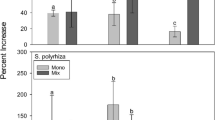Summary
Remobilization of chromium was studied using three types of cells in different physiological states. Cell age was not a factor in chromium remobilization processes. Both fresh and 50 day starved cells showed a similar pattern (rate) of chromium remobilization. Cells exposed to chromium for 50 days (to simulate groundwater conditions) released the most chromium during a 32 day remobilization period.
Similar content being viewed by others
References
American Public Health Association (1989). Standard Methods for the Examination of Water and Wastewater, 17th ed.
Hutchins, S. R., Davidson, M. S., Brierley, J. A., and Brierley, C. L. (1986). Ann. Rev. Microbiol. 40: 311–336.
Kong, S., Johnstone, D. L., Yonge, D. R., Petersen, J. N., and Brouns, T. M. (1992a). Biotechnol. Tech. 6: 143–148.
Kong, S., Yonge, D. R., Johnstone, D. L., Petersen, J. N., and Brouns, T. M. (1992b). Biotechnol. Lett. 14: 521–524.
Kong, S., Johnstone, D. L., Yonge, D. R., Petersen, J. N., and Brouns, T. M. (1992c). Under review, submitted to Appl. Microbiol. Biotechnol.
Author information
Authors and Affiliations
Rights and permissions
About this article
Cite this article
Kong, S., Johnstone, D.L., Yonge, D.R. et al. Remobilization of chromium from starved and fresh subsurface bacterial consortium. Biotechnol Lett 15, 1081–1084 (1993). https://doi.org/10.1007/BF00129942
Issue Date:
DOI: https://doi.org/10.1007/BF00129942




